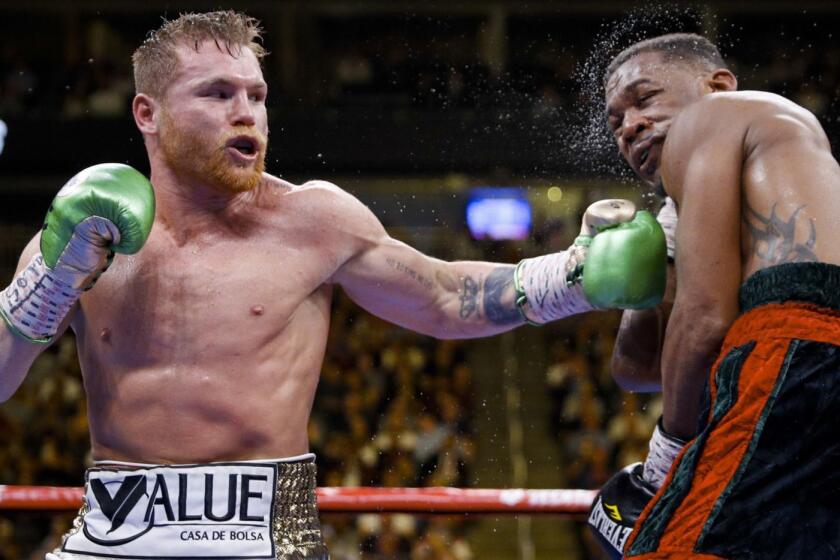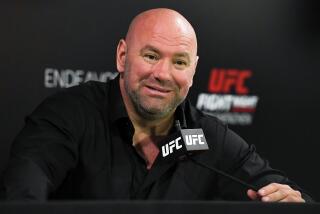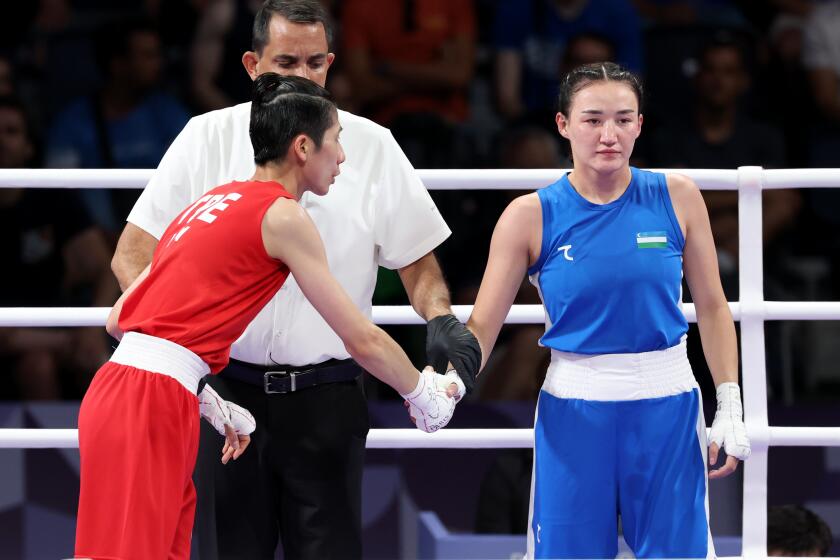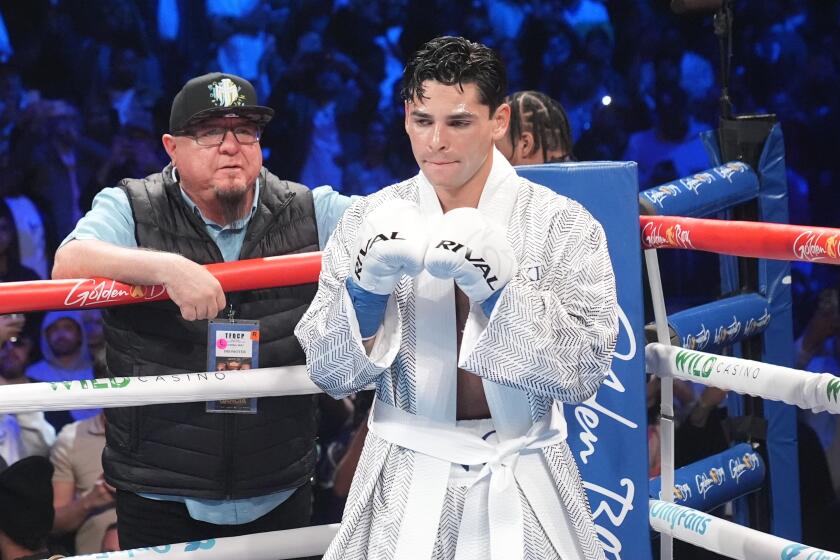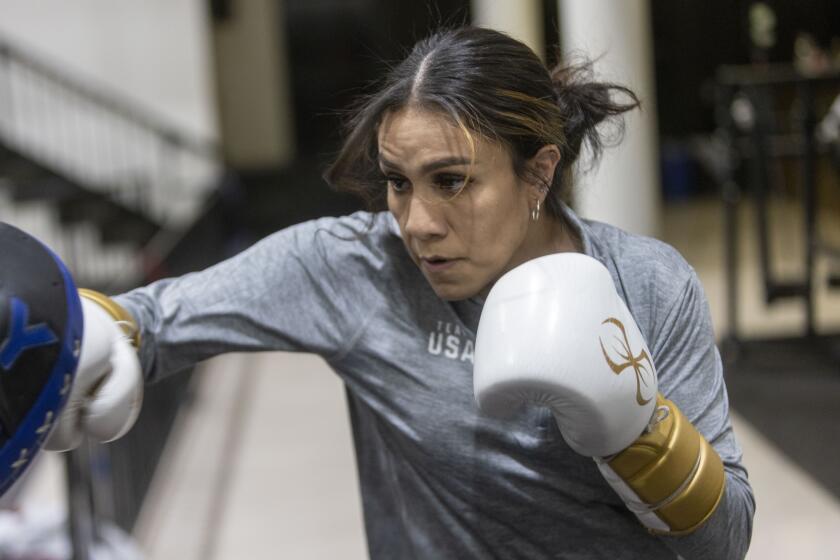Column: Canelo’s unification fight remains true to sport amid circus acts
Floyd Mayweather Jr. fighting a YouTuber? Oscar de la Hoya making a comeback at 48 against who knows who?
Canelo Álvarez didn’t want to hear about any of it.
“That’s not a boxing match,” Álvarez said in Spanish on a recent conference call. “That’s what people have to understand. It’s more of an event, no? Boxing is completely different. We all know that.”
He was right. His protests were also entirely in vain.
The consensus No. 1 boxer in the world, Álvarez will be taking on his most credible opponent in two years, maybe more, when he steps into the ring with Billy Joe Saunders at AT&T Stadium in Dallas on Saturday.
During the last couple of days, however, the 168-pound title fight has been overshadowed by the 44-year-old Mayweather’s exhibition match on June 6 against social media personality Logan Paul, who is best known for filming a suicide victim in a Japanese forest and uploading the video onto his YouTube channel.
At Canelo Álvarez’s gym in San Diego, he’s worked with trainer Eddy Reynoso to prep for Saturday’s fight against Billy Joe Saunders.
In the competition for eyeballs between boxing and the clown shows that make a mockery of the once-proud sport, the fake stuff is claiming the majority of the rounds.
The only boxing match to transcend the sport and become a mainstream attraction over the last year was an eight-round exhibition in November featuring a 54-year-old Mike Tyson and 51-year-old Roy Jones Jr.
On Thursday, the same day Álvarez and Saunders participated in their uneventful final news conference, Mayweather and Paul staged a promotional event in Miami to spread the word about their pay-per-view spectacle.
At one point, Mayweather came nose-to-nose with his opponent’s younger brother, Jake Paul.
The younger Paul snatched a white cap from Mayweather’s head and shouted, “Gotcha hat!” as he tried to scamper away.
Mayweather and his bodyguards jumped Jake, punched him in the eye, stretched the collar of his shirt and recovered the precious headgear.
About an hour later, on his website, Jake was selling merchandise bearing the words, “Gotcha hat.”
Care to guess what received more attention, the well-spoken Álvarez calling Saunders a great fighter or the contrived fracas in Miami?
Álvarez was dismissive when asked last week if boxing promoters could learn anything about selling fights from social media influencers.
“Look” Álvarez said, “the truth is the YouTubers bring another audience, people who watch other things, who like to see [the YouTubers], who come to see a YouTuber make videos and want to see them fight.”
Álvarez touched on something important, on how the interest in these YouTubers as people are what creates interest in their fights.
What he failed, or didn’t want, to see was how similar dynamics set him on the path to stardom. As a teenager, Álvarez was by no means a once-in-a-generation prospect. He was a fluid combination puncher, but his feet were as heavy as his hands. At the time, what separated him from other aspiring champions was the backing of Televisa, Mexico’s largest media company.
Televisa made Alvarez famous before he was a world-class fighter. Which isn’t to say Alvarez is undeserving of his fame. Televisa provided him with a platform and he put in the work to transform himself into a legitimate champion, unlike, say, Julio César Chávez Jr., who was championed by TV Azteca.
This weekend is essentially the Super Bowl of boxing, and for people of Mexican heritage in the U.S., those fights are a communal experience.
It’s also no coincidence the most marketable American fighter — relative to ability, at least — is 22-year-old lightweight contender Ryan García, who is as much an Instagram sensation as he is a boxer. If anything, García might have been too effective at marketing himself, as he withdrew from an upcoming fight to “manage my health and [well-being].”
While Álvarez and García provide reasons to reach out beyond boxing’s bubble and cultivate new fans, the sport generally takes the very opposite approach, searching instead for the niche within its niche audience to price gouge.
Lacking a central authority, the boxing business is basically libertarianism in practice. Most decisions are made to maximize short-term profits, without any regard to the long-term well-being of the sport.
Starting in the 1970s, there was a movement to broadcast high-end matches on pay-per-view and premium cable. The strategy made fights less accessible to non-boxing fans, but what did it matter if people hopelessly addicted to the sport continued to pay the escalating fees?
As a result, the fan base gradually eroded to where HBO dropped boxing 2 1/2 years ago after decades as the sport’s primary driver.
Executives at the streaming service DAZN were thrilled Wednesday by an internal report that showed 1.2 million worldwide viewers for Saturday’s middleweight title victory by Canelo Alvarez.
The boxing fan base is now a loosely-connected network of ethnic enclaves, with fighters often marketed to appeal to a very specific segment of the public. As a Mexican fighter who attracts Mexicans and Mexican Americans, Álvarez has enough support to draw an anticipated 70,000 fans to AT&T Stadium on Saturday. But the fight will have limited appeal outside of the Mexican diaspora, Saunders’ U.K. supporters and the handful of remaining boxing junkies.
Which is a shame because this should actually be a competitive fight. A southpaw with a deceptively sharp jab who moves relatively well for a 168-pound fighter, Saunders represents a significant upgrade from the cannon fodder Alvarez has imported from Europe in his last couple of fights.
Dallas Cowboys owner Jerry Jones, who owns the stadium, didn’t sound as if he even knew what was about to take place, as he was clearly unfamiliar with one of the main-event combatants.
“Billy Joe Sanders,” Jones called him.
The guess here is that he wouldn’t have messed up the name of either of the Paul brothers.
More to Read
Go beyond the scoreboard
Get the latest on L.A.'s teams in the daily Sports Report newsletter.
You may occasionally receive promotional content from the Los Angeles Times.

